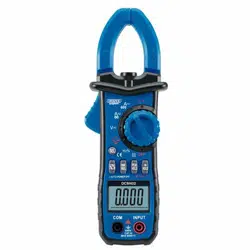Loading ...
Loading ...
Loading ...

Warning
To avoid electrical shock or personal injury.
Please read the safety information and “warnings and precautions” before use.
This is an AC-DC current digital clamp meter (hereinafter referred to as the clamp meter).
The whole circuit design is based on LSI A / D converter with full-scale overload protection
circuit and frequency measurement function.
The Clamp Meter can be used to measure the AC and DC voltage, AC and DC current,
resistance, capacitance, frequency, duty cycle, diodes and temp.
5.1 SAFETY PRECAUTIONS
The instrument strictly follows the GB4793 electronic measuring instrument safety
requirements IEC61010-1 and IEC1010-2-032 safety standards for the design and
production, in line with double insulation, over-voltage CAT III 600V and pollution level 2
safety standards.
Safe working habits
To avoid possible electric shock or personal injury, and to avoid damage to the instrument
or the object to be measured, use the meter in the following ways:
• Inspect the instrument. Do not use the instrument if the case is damaged. Check for
cracks or missing plastic parts. Pay particular attention to the insulating layer of the
connector.
• Inspect the test leads for insulation damage or bare metal. Check the continuity of the
test leads. If the test leads are damaged, replace them before using the instrument.
• Use the instrument to measure a known voltage to make sure the instrument operates
normally. Do not use if the instrument is working abnormally. Protection facilities may
have been damaged. If in doubt, the instrument should be sent for maintenance.
• Do not apply any voltage beyond the rated voltage indicated on the meter between any
terminal and earth ground.
• Warning: When working above 30V use caution not to touch exposed contacts due to
risk of electric shock. Only use the approved probes or clamps.
• Measurements must be made with the correct jack, function and range.
• Do not use the instrument near explosive gases, vapours or dust.
• When using the test leads, keep your fingers behind the test lead protector.
• When connecting, first connect the common test lead, and then connect the live test
lead. When disconnect, the live test lead and then disconnect the common test lead.
• Before you test the resistance, continuity and diodes, you must first cut off the power,
and discharge all the capacitors.
• If the meter is not used in accordance with the instructions, the safety protection
provided by the instrument may be impaired or invalidated.
• Ensure the instrument is switched off when opening the battery cover.
• When the battery under voltage indicator “ ” lights up, immediately replace the
battery. When the battery power is low, the meter may produce incorrect readings,
resulting in electric shock and personal injury. DO NOT mix new and old batteries and
do not use re-chargeable batteries.
• Before opening the battery cover, the test leads must be removed from the instrument.
• Please use a soft cloth to clean instrument case, do not use abrasives or solvents.
5. HEALTH & SAFETY INFORMATION
10
Loading ...
Loading ...
Loading ...
